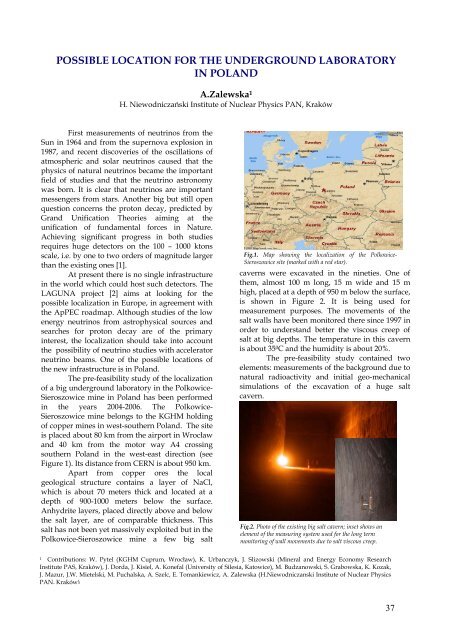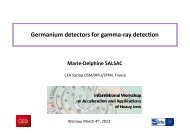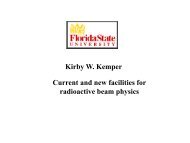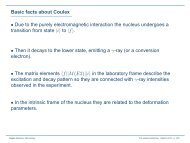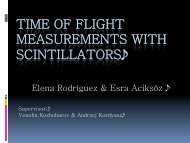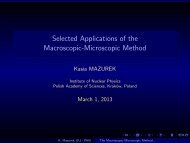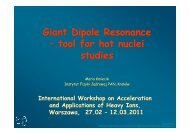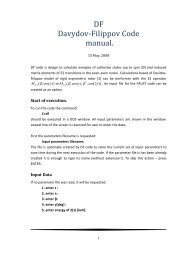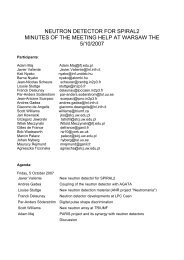nuclear physics in poland 1996 â 2006
nuclear physics in poland 1996 â 2006
nuclear physics in poland 1996 â 2006
- No tags were found...
You also want an ePaper? Increase the reach of your titles
YUMPU automatically turns print PDFs into web optimized ePapers that Google loves.
POSSIBLE LOCATION FOR THE UNDERGROUND LABORATORYIN POLANDA.Zalewska 1H. Niewodniczański Institute of Nuclear Physics PAN, KrakówFirst measurements of neutr<strong>in</strong>os from theSun <strong>in</strong> 1964 and from the supernova explosion <strong>in</strong>1987, and recent discoveries of the oscillations ofatmospheric and solar neutr<strong>in</strong>os caused that the<strong>physics</strong> of natural neutr<strong>in</strong>os became the importantfield of studies and that the neutr<strong>in</strong>o astronomywas born. It is clear that neutr<strong>in</strong>os are importantmessengers from stars. Another big but still openquestion concerns the proton decay, predicted byGrand Unification Theories aim<strong>in</strong>g at theunification of fundamental forces <strong>in</strong> Nature.Achiev<strong>in</strong>g significant progress <strong>in</strong> both studiesrequires huge detectors on the 100 – 1000 ktonsscale, i.e. by one to two orders of magnitude largerthan the exist<strong>in</strong>g ones [1].At present there is no s<strong>in</strong>gle <strong>in</strong>frastructure<strong>in</strong> the world which could host such detectors. TheLAGUNA project [2] aims at look<strong>in</strong>g for thepossible localization <strong>in</strong> Europe, <strong>in</strong> agreement withthe ApPEC roadmap. Although studies of the lowenergy neutr<strong>in</strong>os from astrophysical sources andsearches for proton decay are of the primary<strong>in</strong>terest, the localization should take <strong>in</strong>to accountthe possibility of neutr<strong>in</strong>o studies with acceleratorneutr<strong>in</strong>o beams. One of the possible locations ofthe new <strong>in</strong>frastructure is <strong>in</strong> Poland.The pre-feasibility study of the localizationof a big underground laboratory <strong>in</strong> the Polkowice-Sieroszowice m<strong>in</strong>e <strong>in</strong> Poland has been performed<strong>in</strong> the years 2004-<strong>2006</strong>. The Polkowice-Sieroszowice m<strong>in</strong>e belongs to the KGHM hold<strong>in</strong>gof copper m<strong>in</strong>es <strong>in</strong> west-southern Poland. The siteis placed about 80 km from the airport <strong>in</strong> Wrocławand 40 km from the motor way A4 cross<strong>in</strong>gsouthern Poland <strong>in</strong> the west-east direction (seeFigure 1). Its distance from CERN is about 950 km.Apart from copper ores the localgeological structure conta<strong>in</strong>s a layer of NaCl,which is about 70 meters thick and located at adepth of 900-1000 meters below the surface.Anhydrite layers, placed directly above and belowthe salt layer, are of comparable thickness. Thissalt has not been yet massively exploited but <strong>in</strong> thePolkowice-Sieroszowice m<strong>in</strong>e a few big saltFig.1. Map show<strong>in</strong>g the localization of the Polkowice-Sieroszowice site (marked with a red star).caverns were excavated <strong>in</strong> the n<strong>in</strong>eties. One ofthem, almost 100 m long, 15 m wide and 15 mhigh, placed at a depth of 950 m below the surface,is shown <strong>in</strong> Figure 2. It is be<strong>in</strong>g used formeasurement purposes. The movements of thesalt walls have been monitored there s<strong>in</strong>ce 1997 <strong>in</strong>order to understand better the viscous creep ofsalt at big depths. The temperature <strong>in</strong> this cavernis about 35 0 C and the humidity is about 20%.The pre-feasibility study conta<strong>in</strong>ed twoelements: measurements of the background due tonatural radioactivity and <strong>in</strong>itial geo-mechanicalsimulations of the excavation of a huge saltcavern.Fig.2. Photo of the exist<strong>in</strong>g big salt cavern; <strong>in</strong>set shows anelement of the measur<strong>in</strong>g system used for the long termmonitor<strong>in</strong>g of wall movements due to salt viscous creep.1 Contributions: W. Pytel (KGHM Cuprum, Wrocław), K. Urbanczyk, J. Slizowski (M<strong>in</strong>eral and Energy Economy ResearchInstitute PAS, Kraków), J. Dorda, J. Kisiel, A. Konefal (University of Silesia, Katowice), M. Budzanowski, S. Grabowska, K. Kozak,J. Mazur, J.W. Mietelski, M. Puchalska, A. Szelc, E. Tomankiewicz, A. Zalewska (H.Niewodniczanski Institute of Nuclear PhysicsPAN, Kraków)37


